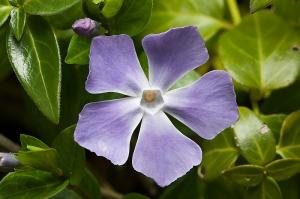Blue Periwinkle

Vinca major, more commonly known as Bigleaf Periwinkle, Large Periwinkle, Greater Periwinkle and Blue Periwinkle is an evergreen trailing vine that spreads along the ground, rooting at the nodes to form dense masses of groundcover. Vinca major is noted for being an extremely fast growing plant, so much so that a single specimen can cover an area 15’ or more with a dense carpet of shiny dark green foliage in just a couple of months. The leaves are 2-3 inches long, oval or heart shaped and grow in pairs opposite each other along the length of the stem. The flowers, borne singly in the leaf axils on ascending stems are blue-violet, funnel shaped with five petals and about 2 inches across. Big periwinkle flowers heavily throughout the spring and sporadically during the summer.
Information regarding the specific toxicity of Vinca major varies from source to source, although all sources agree that the plants contain an extensive array of alkaloids. They also contain saponins and various other compounds. The alkaloid content also seems to vary from region to region, especially between areas where they grow as annuals rather than perennials. Of the more than 130 compounds found in vinca major, the principal components include vindoline, vincamine and vincadifformine. Many of the alkaloids, including akuammine, perivincine, reserpinine, and vinine, are hypotensive, although to what extent is not fully understood. When ingested the overall effect of these compounds is a reduction in blood pressure and in exceptionally large doses possible systematic paralysis and death. It should be noted that large ingestions of vinca major are extremely rare; most animals consider the plant to be unpalatable.
Avoid further ingestion of the plant and consult a veterinarian. Life threatening intoxication in animals is exceedingly rare and fatal intoxications rarer yet. There is no specific antidote for ingestion of periwinkle, although serious medical treatment is rarely required. Despite the plants long history of use in holistic medicine and widespread cultivation as a flowering ornamental for ground cover, there have been practically no reports of intoxication associated with its ingestion by livestock or pets. As a result there is very little information available about how it affects animals from which one could craft a specific treatment regimen. The University of Arkansas, Division of Agriculture notes that “plants can cause systemic toxicity varying from mild abdominal cramping to serious cardiac (heart) complications”. This, however, is referring to human ingestion of the plant, and not pet or livestock ingestion. Additionally humans may show more severe intoxications as they may choose to intentionally ingest large amounts of the plant in various forms or concentrations for holistic purposes. Whereas animals have been noted to avoid the plant due its lack of palatability, even when other food resources were limited.
In regards to a specific treatment regimen, common sense symptomatic care will probably be all that is required. . If the ingestion was recent remove any existing plant matter from the mouth and if vomiting does not occur it may be induced by giving a teaspoon or less (size dependent) of 3% hydrogen peroxide orally. The pet will more than likely start vomiting on their own without the help, as their body tries to expel this non digestible material. Ensure the pet gets plenty of fluids to avoid possible dehydration caused by diarrhea. To alleviate the gastrointestinal upset and diarrhea Kapectolin may be given at a dose rate of 1 to 2 ml/kg four times a day. Kapectolin provides a coating action that protects the stomach lining. Sucralfate may also be used as for gastrointestinal irritation as it reacts with the acids in the stomach to form a paste-like material capable of acting as a barrier between the stomach and its contents. Sucralfate is typically given to dogs weighing more the 60lbs: 1g every 6 to 8 hours; for dogs under 60 lbs: 0.5g every 6 to 8 hours; Cats: 0.25g every 8 to 12 hours to reduce irritation of the stomach and intestines. The prognosis will depend on the severity of the intoxication, however serious intoxications of animals are exceptionally rare and in most cases symptoms will be limited to gastrointestinal upset (vomiting and diarrhea).




